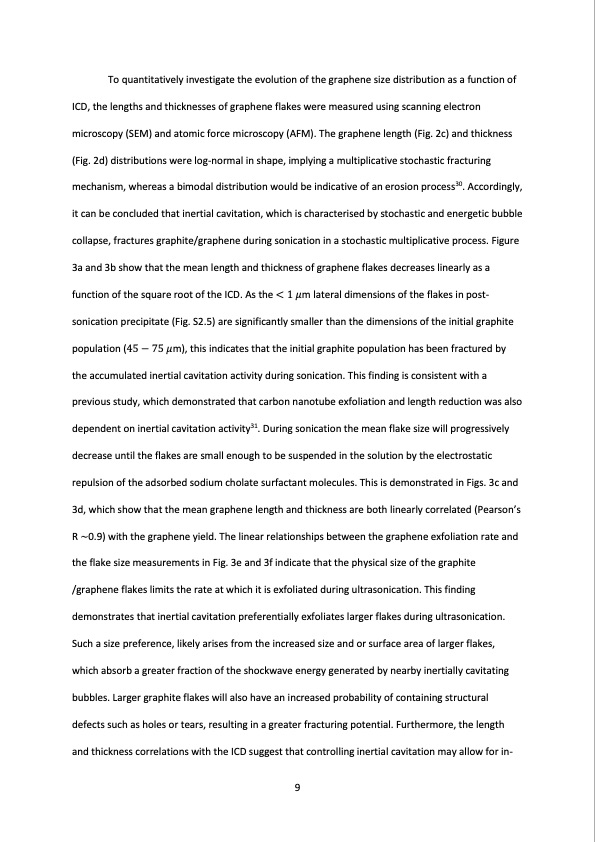
PDF Publication Title:
Text from PDF Page: 009
To quantitatively investigate the evolution of the graphene size distribution as a function of ICD, the lengths and thicknesses of graphene flakes were measured using scanning electron microscopy (SEM) and atomic force microscopy (AFM). The graphene length (Fig. 2c) and thickness (Fig. 2d) distributions were log-normal in shape, implying a multiplicative stochastic fracturing mechanism, whereas a bimodal distribution would be indicative of an erosion process30. Accordingly, it can be concluded that inertial cavitation, which is characterised by stochastic and energetic bubble collapse, fractures graphite/graphene during sonication in a stochastic multiplicative process. Figure 3a and 3b show that the mean length and thickness of graphene flakes decreases linearly as a function of the square root of the ICD. As the < 1 𝜇m lateral dimensions of the flakes in post- sonication precipitate (Fig. S2.5) are significantly smaller than the dimensions of the initial graphite population (45 − 75 𝜇m), this indicates that the initial graphite population has been fractured by the accumulated inertial cavitation activity during sonication. This finding is consistent with a previous study, which demonstrated that carbon nanotube exfoliation and length reduction was also dependent on inertial cavitation activity31. During sonication the mean flake size will progressively decrease until the flakes are small enough to be suspended in the solution by the electrostatic repulsion of the adsorbed sodium cholate surfactant molecules. This is demonstrated in Figs. 3c and 3d, which show that the mean graphene length and thickness are both linearly correlated (Pearson’s R ~0.9) with the graphene yield. The linear relationships between the graphene exfoliation rate and the flake size measurements in Fig. 3e and 3f indicate that the physical size of the graphite /graphene flakes limits the rate at which it is exfoliated during ultrasonication. This finding demonstrates that inertial cavitation preferentially exfoliates larger flakes during ultrasonication. Such a size preference, likely arises from the increased size and or surface area of larger flakes, which absorb a greater fraction of the shockwave energy generated by nearby inertially cavitating bubbles. Larger graphite flakes will also have an increased probability of containing structural defects such as holes or tears, resulting in a greater fracturing potential. Furthermore, the length and thickness correlations with the ICD suggest that controlling inertial cavitation may allow for in- 9PDF Image | Cavitation Liquid Phase Exfoliation of Graphene

PDF Search Title:
Cavitation Liquid Phase Exfoliation of GrapheneOriginal File Name Searched:
1809-07630.pdfDIY PDF Search: Google It | Yahoo | Bing
Salgenx Redox Flow Battery Technology: Power up your energy storage game with Salgenx Salt Water Battery. With its advanced technology, the flow battery provides reliable, scalable, and sustainable energy storage for utility-scale projects. Upgrade to a Salgenx flow battery today and take control of your energy future.
| CONTACT TEL: 608-238-6001 Email: greg@infinityturbine.com | RSS | AMP |